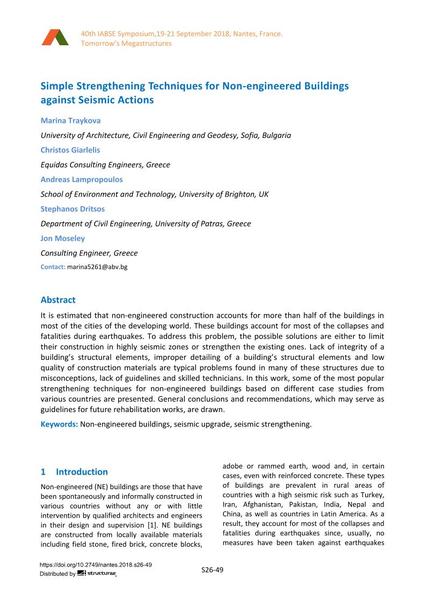Simple Strengthening Techniques for Non-engineered Buildings against Seismic Actions

|
|
|||||||||||
Bibliographic Details
| Author(s): |
Marina Traykova
(University of Architecture, Civil Engineering and Geodesy, Sofia, Bulgaria)
Christos Giarlelis (Equidas Consulting Engineers, Greece) Andreas Lampropoulos (School of Environment and Technology, University of Brighton, UK) Stephanos Dritsos (Department of Civil Engineering, University of Patras, Greece) Jon Moseley (Consulting Engineer, Greece) |
||||
|---|---|---|---|---|---|
| Medium: | conference paper | ||||
| Language(s): | English | ||||
| Conference: | IABSE Symposium: Tomorrow’s Megastructures, Nantes, France, 19-21 September 2018 | ||||
| Published in: | IABSE Symposium Nantes 2018 | ||||
|
|||||
| Page(s): | S26-49 | ||||
| Total no. of pages: | 8 | ||||
| DOI: | 10.2749/nantes.2018.s26-49 | ||||
| Abstract: |
It is estimated that non-engineered construction accounts for more than half of the buildings in most of the cities of the developing world. These buildings account for most of the collapses and fatalities during earthquakes. To address this problem, the possible solutions are either to limit their construction in highly seismic zones or strengthen the existing ones. Lack of integrity of a building’s structural elements, improper detailing of a building’s structural elements and low quality of construction materials are typical problems found in many of these structures due to misconceptions, lack of guidelines and skilled technicians. In this work, some of the most popular strengthening techniques for non-engineered buildings based on different case studies from various countries are presented. General conclusions and recommendations, which may serve as guidelines for future rehabilitation works, are drawn. |
||||
| Keywords: |
seismic strengthening Non-engineered buildings seismic upgrade
|
||||
